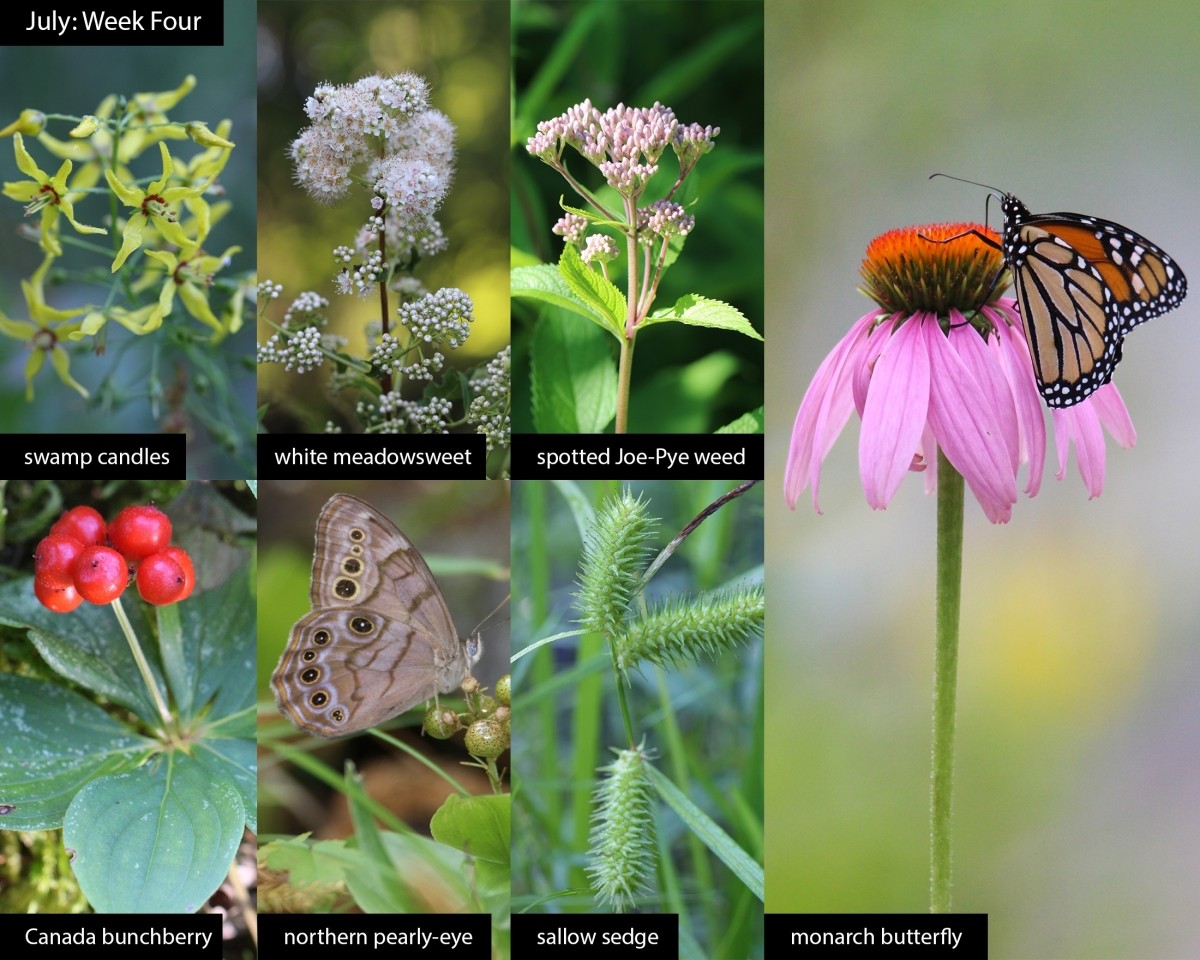This week in the woods, along the Linny Levin Trail through the Zebedee Wetlands in Thetford, Vermont, a number of blooms, berries, and butterflies were at or around their peak abundance.
Swamp candles (plural even in singular form) also goes by common names like swamp loosestrife, yellow loosestrife, and earth loosestrife, but the native, golden-flowered perennial belongs to a different genus (Lysimachia) than the notorious invasive purple loosestrife (Lythrum salicaria – unfortunately also present in this wetland).
As it does in this case, swamp candles often shares wet habitat with white meadowsweet and spotted Joe-Pye weed, both plants now in bloom, highly attractive to pollinators (especially late in the season), and relatively resistant to deer browse. The woody shrub white meadowsweet produces dense conical clusters of miniature pale flowers at the end of its straight, unbranched stems; it hosts larvae for the spring azure (or holly blue) butterfly. Purple-pink Joe-Pye weed flowers grow in compound arrays at the ends of purple, sometimes spotted stems that can reach seven feet tall and sport whorls of long, toothy, lance-shaped leaves.
Canadian bunchberry’s eponymous bunches of berries have begun replacing their flowers, the incredible speed of which we wrote about in June. You can find the edible but large-seeded fruit between now and September, in a range of cool, moist sites.
This northern pearly-eye appeared in the wooded area where Zebedee Brook meets the wetland; these large butterflies most often appear near running water, and one of the five rivers in Hades in Greek mythology gives them their genus its name, Lethe, which means “forgetfulness” or “oblivion.” As this Missouri Department of Conservation species account suggests, the dark name reflects a preference for dark habitat, and the northern pearly-eye occupies shady woodland environments more often than open fields and flowery forest margins. The short-proboscised pearly-eye doesn’t depend on nectar and rather consumes fungi, sap, scat, and carrion. While seen here on Canada mayflower fruit, it rests more often on tree trunks, where its grays and browns help it blend in. In cases where it fails to blend in, the dark false “eyes” at the bases of its wings create alternative targets to its body and head; a predator can clip these spots and the now ragged-winged insect can still survive.
While the northern pearly-eye generally uses grasses as larval host plants, some northern populations like ours employ sedges. This sedge (most likely a sallow sedge, also known as shallow sedge or lurid sedge) grew not far from where we spotted the pearly-eye. Sedges produce achenes, these dry, one-seeded fruit that do not open upon maturity.
Away from the wetland, in a drier and more open area, we snapped some paparazzi photos of this monarch butterfly, perhaps the most famous butterfly in the world. The monarch gains its fame for its beauteous orange-amber wings, some populations’ remarkable multigenerational migrations between Mexican wintering grounds and points north, and, more recently, its declining numbers. While they are also well-known for their dependence on milkweed because their larvae eat its leaves exclusively, monarch adults consume nectar from numerous other blooming species, like purple coneflower here. The final generation of the summer will delay sexual maturity and live between 6 and 9 months, long enough to allow time for migration, overwintering, and a partial return journey, but this individual and its generation will only last 6 to 8 weeks.
What have you noticed in the woods this week? Submit a recent photo for possible inclusion in our monthly online Reader Photo Gallery.



Discussion *